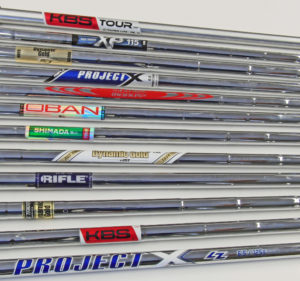 The importance of shaft weight in fitting golf clubs cannot be overstated. If you look at the picture to the left, these are just a few of the steel iron shafts available and they run the range from 85 grams to 130 grams. This may not seem like much but weight can dramatically change your performance.
The importance of shaft weight in fitting golf clubs cannot be overstated. If you look at the picture to the left, these are just a few of the steel iron shafts available and they run the range from 85 grams to 130 grams. This may not seem like much but weight can dramatically change your performance.
In general, golfers with slower swing speed and tempo can and should play a lighter shaft. Golfers with very fast speeds and tempo should play heavier shafts. Driver shafts typically weigh 55-60 grams for men and 45-50 grams for ladies. Iron shafts can be as light as 55 grams in graphite, and 130 grams in steel. The professional tours offer great examples. LPGA driver shafts are typically 50 to 65 grams while the PGA Tour driver shafts are 60 to 85 grams. Strength, tempo and preferred club length play a huge roll in determining shaft weight and swing weight.
Progressive weighting: This is a very important concept that simply means longer clubs should have lighter weight shafts than shorter clubs. It starts with the driver and goes progressively heavier from there. For example, a golfer with an 75-80 mph swing speed and a smooth tempo would play roughly a 50 gram shaft in his driver, 60 gram shaft in the fairway woods, 70 gram shaft in hybrids, and 80 gram shafts in irons. All of this is subject, of course, to a fitter and launch monitor data.
Impact of Shaft Weight on Performance: Having been in this industry for twenty years, I see trends come and go. One thing is certain. Nobody wants to hit a new club any shorter than their current club! In the quest for distance, we continue to see shafts, and in some cases heads (Tour Edge XJ1) getting lighter. The theory is that lighter weight can help create more swing speed. While this is true, here is what we see in our fittings:
- If the club weight is TOO light,
- Club speed can increase but contact on the club face is erratic which reduces ball speed and distance.
- Shot dispersion can become erratic both long and short, and left and right.
- Trajectory can get higher as light shafts typically have higher launch characteristics.
- If the club weight is TOO heavy,
- Club speed can decrease causing ball speed to decrease with subsequent loss in distance.
- Shot dispersion MAY improve but it could be more right or left of target.
- Trajectory MAY get lower or higher depending upon the golfers attack angle.
Just like anything, there are exceptions to these rules. It is really important to understand that swing tempo, transition from back to forward swing, and release point can have a big impact on shaft weight. Our BGF Fitting System takes these factors into account as well as swing speed to make very precise shaft weight recommendations. Then, using TrackMan data, we test different shaft weight and flex options to optimize our golfers performance with every club in their bag.
So before you make a decision to get the latest light weight driver, or go from steel shafts to graphite because you are getting a little older, go see a qualified clubfitter and get dialed in. Weight, in some instances, can be your friend!
Dan Sueltz
